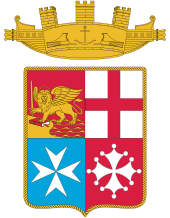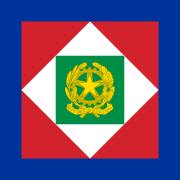Emblem of Italy
| Emblem of the Italian Republic | |
|---|---|
 | |
| Versions | |
 Golden version, used on the presidential standard | |
| Armiger | Italian Republic (colored) Sergio Mattarella, President of the Italian Republic (golden) |
| Adopted | 5 May 1948 |
| Crest | None |
| Shield | Upon a cogwheel proper, the Stella d'Italia ("Star of Italy") |
| Supporters | Olive and oak |
| Motto | REPVBBLICA ITALIANA[a] |
The emblem of the Italian Republic (Italian: emblema della Repubblica Italiana) was formally adopted by the newly formed Italian Republic on 5 May 1948. Although often referred to as a coat of arms (or stemma in Italian), it is an emblem as it was not designed to conform to traditional heraldic rules. The emblem is used extensively by the Italian government.
The emblem, shaped as a Roman wreath, comprises a white five-pointed star, the Stella d'Italia (English: "Star of Italy"), which is the oldest national symbol of Italy, since it dates back to the Greco-Roman tradition,[1] with a thin red border, superimposed upon a five-spoked cogwheel, standing between an olive branch to the left side and an oak branch to the right side; the branches are in turn bound together by a red ribbon with the inscription in "REPVBBLICA ITALIANA" in Roman square capitals.[a]
The armorial bearings of the House of Savoy, blazoned gules a cross argent, were previously in use by the former Kingdom of Italy; the supporters, on either side a lion rampant Or, were replaced with fasci littori (lit. 'bundles of the lictors') during the fascist era.
Description
[edit]

The central element of the emblem is the five-pointed star white star, also called Stella d'Italia (English: "Star of Italy"), which is the oldest national symbol of Italy, since it dates back to ancient Greece.[1] In this historical epoch Italy was associated with the Star of Venus because it was located west of the Hellenic peninsula.[2] Venus, immediately after sunset, is sometimes visible on the horizon towards the west.[1] It is the traditional symbolic representation of Italy since the Risorgimento and refers to the traditional iconography that Italy wants to portray as an attractive woman surrounded by a turreted crown - from which the allegory of Italia turrita - and dominated by a bright star, the Star of Italy.[3]
The star marked the first award of Republican reconstruction, the Order of the Star of Italian Solidarity, and still indicates membership of the Armed Forces today.
On the republican emblem, the Star of Italy is superimposed on a steel cogwheel, representing labour, which is the foundation of the Republic.[4] Article 1 of the Italian Constitution reads:[5]
Italy is a democratic republic, built on labour. Sovereignty belongs to the people, who exercise it in the forms and within the limits of the Constitution [...]

However, this reference to labour is not to be understood as a legal rule, which would oblige the State to protect it in detail, but rather to refer to the principle connected to it, which is the foundation of Italian society.[5] The second paragraph, instead, assigning sovereignty exclusively to the people, establishes the democratic character of the republic.[6] The cogwheel is also present on the flag and emblem of Angola and on the emblem of Mozambique, nations left by the process of decolonization of the Portuguese Empire[7][8] as well as on the coat of arms of the Italian municipalities of Assago, Cafasse and Chiesina Uzzanese.
The set formed by the cogwheel and the star of Italy is enclosed by an oak branch, located on the right, which symbolizes the strength and dignity of the Italians (in Latin the term robur means both oak and moral strength and physics,[9]) and from an olive branch, located instead on the left, which represents Italy's will for peace, both internally and vis-à-vis other nations.[4] Both oak and olive trees are characteristic of the Italian landscape. The green branches are in turn bound together by a red ribbon bearing the inscription REPVBBLICA ITALIANA in white capital letters. As regards Italy's desire for peace, Article 11 of the Constitution states:[10]
Italy rejects war as an instrument of offense against the freedom of other peoples and as a means of resolving international disputes; allows equal conditions with other states to the limitations of sovereignty necessary for an order that ensures peace and justice between nations; promotes and favors international organizations aimed at this purpose [...]
The refusal of war as an instrument of offense does not signify that Italy cannot participate in a conflict, instead that articles 78 and 87 of the Constitution prescribe which state organs decide the state of war.[5] In particular, for Italy, it is the two chambers that decree the state of war, which is then formally declared by the President of the Republic; the chambers then give the Italian government the necessary powers to face the conflict.[11] Another extraordinary provision in case of war is the duration of the legislature of the two chambers, which can be exceptionally extended, as stated in article 103 of the Constitution, beyond the five canonical years.[11]
The emblem of the Italian Republic is not defined as a coat of arms as it has no shield; the latter being in fact, according to the heraldic definition, an essential part of such devices (as opposed to other decorations such as, for example, crowns, helmets or fronds, which are accessory parts). For this reason, it is more correct to refer to it as a "national emblem".[12]
Armed forces
[edit]
The Italian naval ensign, since 1947, comprises the national flag defaced with the arms of the Marina Militare: The shield is quartered, symbolic of the four repubbliche marinare, or great thalassocracies, of Italy: Venice (represented by the lion passant, top left), Genoa (top right), Amalfi (bottom left), and Pisa (represented by their respective crosses). The Marina Mercantile (and private citizens at sea) use the civil ensign, differenced by the absence of the mural crown and the lion holding open the gospel, bearing the inscription PAX TIBI MARCE EVANGELISTA MEVS instead of a sword.[13]
To acknowledge the Navy's origins in ancient Rome, the rostrata crown, "... emblem of honor and of value that the Roman Senate conferred on duci of shipping companies, conquerors of lands and cities overseas," was proposed by Admiral Cavagnari in 1939. An inescutcheon, bearing the Savoy shield flanked by fasces, was removed before the arms were first employed.[14]
The Esercito Italiano, Aeronautica Militare and Arma dei Carabinieri also have their own distinctive coats of arms as do each of the municipalities, provinces and regions of Italy.
History
[edit]Kingdom of Italy (Napoleonic)
[edit]The Kingdom of Italy was a French client state founded in Northern Italy by Napoleon I, Emperor of the French in 1805. It had a peculiar coat of arms, formed by the arms of the House of Bonaparte augmented by charges from various Italian regions. When Napoleon abdicated the thrones of France and Italy in 1814, the former monarchies were gradually re-established and following the Treaty of Paris in 1815, the rump was annexed by the Austrian Empire.
Kingdom of Italy
[edit]Between 1848 and 1861, a sequence of events led to the independence and unification of Italy (except for Venetia, Rome, Trento and Trieste, or Italia irredenta, which were united with the rest of Italy in 1866, 1870 and 1918 respectively); this period of Italian history is known as the Risorgimento, or resurgence. During this period, the green, white and red tricolore became the symbol which united all the efforts of the Italian people towards freedom and independence.[15]
The Italian tricolour, defaced with the coat of arms of the House of Savoy, was first adopted as war flag by the Regno di Sardegna-Piemonte (Kingdom of Sardinia-Piedmont) army in 1848. In his Proclamation to the Lombard-Venetian people, Charles Albert said "… in order to show more clearly with exterior signs the commitment to Italian unification, We want that Our troops … have the Savoy shield placed on the Italian tricolour flag."[16] As the arms mixed with the white of the flag, it was fimbriated azure, blue being the dynastic colour.[17] On 15 April 1861, when the Regno delle Due Sicilie (Kingdom of the Two Sicilies) was incorporated into the Regno d'Italia, after defeat in the Expedition of the Thousand led by Giuseppe Garibaldi, this flag and the armorial bearings of Sardinia were declared the symbols of the newly formed kingdom.
On 4 May 1870, nine years later, the Consulta Araldica issued a decree on the arms, as with the Sardinian arms, two lions rampant in gold supporting the shield, bearing instead only the Savoy cross (as on the flag) now representing all Italy, with a crowned helmet, around which, the collars of the Military Order of Savoy, the Civil Order of Savoy, the Order of the Crown of Italy (established 2 February 1868), the Order of Saints Maurice and Lazarus, and the Supreme Order of the Most Holy Annunciation (bearing the motto FERT) were suspended. The lions held lances flying the national flag. From the helmet fell a royal mantle, engulfed by a pavilion under the Stellone d'Italia, purported to protect the nation.[18]
After twenty years, on 1 January 1890, the arms' exterior were slightly modified more in keeping with those of Sardinia. The fur mantling and lances disappeared and the crown was taken from the helmet to the pavilion, now sewn with crosses and roses. The Iron Crown of Lombardy was placed on the helmet, under the traditional Savoyan crest (a winged lionhead), which, together with the banner of Savoy from the former Sardinian arms, replaced the star of Italy.[19] These arms remained in official use for 56 years until the birth of the Italian Republic and continue today as the dynastic arms of the head of the House of Savoy.[20]
On 11 April 1929, the Savoy lions were replaced by Mussolini with fasces from the National Fascist Party shield.[21] After his dismissal and arrest on 25 July 1943 however, the earlier version was briefly restored until the emblem of the new Repubblica Italiana was adopted, after the institutional referendum on the form of the state, held on 2 June 1946. This is celebrated in Italy as Festa della Repubblica.
Italian Social Republic
[edit]The arms of the short-lived Nazi puppet state in northern Italy, the Repubblica Sociale Italiana (Italian Social Republic), or Republic of Salò as it was commonly known, was that of the governing Republican Fascist Party, a silver eagle clutching a banner of the tricolore inverted on a shield charged with fasces.[22] Italian fascism derived its name from the fasces, which symbolises authority and/or "strength through unity". The fasces has been used to show the imperium (power) of the Roman Empire, and was thus considered an appropriate heraldic symbol. Additionally, Roman legions had carried the aquila, or eagle, as signa militaria.
This shield had previously been displayed alongside the Royal arms from 1927 to 1929, when the latter was modified to incorporate elements of both.[23]
On 25 April 1945, commemorated as Festa della Liberazione, the government of Benito Mussolini fell. The separate Italian Social Republic had existed for slightly more than one and a half years.
Italian Republic
[edit]The decision to provide the new Italian Republic with an emblem was taken by the government of Alcide De Gasperi in October 1946. The design was chosen by public competition, with the requirement that political party emblems were forbidden and the inclusion of the Stellone d'Italia (English: "Great Star of Italy"), "inspired by a sense of the earth and municipalities." The five winners were assigned further requirements for the design of the emblem, "a ring that has towered shaped crown," surrounded by a garland of Italian foliage and flora.
Below a representation of the sea, and above, the gold star, with the legend Unità e Libertà or Unity and Liberty in the Italian language. The winner was Paolo Paschetto, Professor of the Institute of Fine Arts in Rome from 1914 to 1948, and the design was presented in February 1947, together with the other finalists, in an exhibition in Via Margutta. This version, however, did not meet with public approval, so a new competition was held, again won by Paolo Paschetto. The new emblem was approved by the Constituent Assembly in February 1948, and officially adopted by the President of the Italian Republic, Enrico De Nicola, in May 1948.[24][25]
-
Coat of arms of Napoleonic Italy (1805–1814)
-
Coat of arms of the Kingdom of Sardinia during Italian unification, and the first coat of arms of the Kingdom of Italy
-
Greater coat of arms of the Kingdom of Italy (1861–1878)
-
Full achievement of the coat of arms, 1890–1929 and 1943–1946
-
As modified during the Fascist regime, 1929–1943
-
Coat of arms of the Italian Social Republic, 1944–1945
Gallery
[edit]-
Emblem rendered in black and white (with striped backgrounds)
-
Presidential standard of Italy (since 2000)
-
Standard of the deputy president of the Italian Republic (since 1986)
-
Standard of the president of the Council of Ministers of the Italian Republic (since 2008)
-
Standard of the civil authorities
-
Emblem on government letterhead
-
Emblem on an Italian passport
-
European Health Insurance Card issued in Italy showing the emblem
See also
[edit]- Armorial of Italy
- Coat of arms of Napoleonic Italy
- Il Canto degli Italiani
- National symbols of Italy
- Stella d'Italia
Notes
[edit]- ^ a b Repubblica Italiana is Italian for "Italian Republic", with the U – absent from the classical Latin alphabet – spelt with a V, as is common in inscriptions and heraldry.
Citations
[edit]- ^ a b c Rossi 2014, p. 38.
- ^ Bazzano 2011, p. 101.
- ^ cfr. Cesare Ripa, Iconologia, sec. XVI
- ^ a b "I simboli della Repubblica – L'emblema" (in Italian). Retrieved 10 October 2019.
- ^ a b c Villa 2010, p. 137.
- ^ Villa 2010, pp. 137–138.
- ^ "Bandiere". Retrieved 12 April 2017.
- ^ "Bandiere". Retrieved 12 April 2017.
- ^ Villa 2010, p. 139.
- ^ Villa 2010, p. 138.
- ^ a b "Costituzione della Repubblica Italiana" (PDF) (in Italian). Retrieved 11 April 2017.
- ^ "E l'astro del mattino diventò lo stellone d'Italia" (in Italian). Archived from the original on 1 July 2012.
- ^ Decreto Legislativo del capo provvisorio dello stato n. 1305 del 9 novembre 1947 (GU 275 del 29 novembre 1947)
- ^ "Emblema di onore e di valore che il Senato romano conferiva ai duci di imprese navali, conquistatori di terre e città oltremare;" La Bandiera della Marina Militare Archived 2008-09-15 at the Wayback Machine Ministero della Difesa (retrieved 5 October 2008)
- ^ Ghisi, Enrico Il tricolore italiano (1796-1870) Milano: Anonima per l'Arte della Stampa, 1931; see Gay, H. Nelson in The American Historical Review Vol. 37 No. 4 (pp. 750-751), July 1932 JSTOR 1843352
- ^ "Per viemmeglio dimostrare con segni esteriori il sentimento dell'unione italiana vogliamo che le Nostre truppe ... portino lo scudo di Savoia sovrapposto alla bandiera tricolore italiana." See Lawrence, D.H. (ed. Philip Crumpton) Movements in European History (p. 230) Cambridge University Press, 1989 for an overview
- ^ Lo Statuto Albertino Art. 77, dato in Torino addì quattro del mese di marzo l'anno del Signore mille ottocento quarantotto, e del Regno Nostro il decimo ottavo
- ^ Deliberazione della Consulta Araldica del Regno d’Italia con cui si determina quali debbano essere gli ornamenti esteriori dello stemma dello Stato Archived 2007-09-09 at the Wayback Machine, 4 maggio 1870; Regio Decreto n. 7282 del 27 novembre 1890
- ^ Armi della Real Casa d'Italia Archived 2011-07-18 at the Wayback Machine Corpo della Nobiltà Italiana; Gli stemmi della Famiglia Reale sono regolati dal relativo Regio Decreto del 1 gennaio 1890 e gli stemmi dello Stato e delle Amministrazioni governative sono regolati dal Regio Decreto del 27 novembre 1890
- ^ Compiti, Prerogative e Responsabilità del Capo di Casa Savoia nell'Italia Repubblicana Archived 2012-02-14 at the Wayback Machine Reale Casa d'Italia (retrieved 24 January 2009)
- ^ Regio Decreto n. 504 del 11 aprile 1929 VII
- ^ Foggia della bandiera nazionale e della bandiera di combattimento delle Forze Armate Decreto Legislativo del Duce della Repubblica Sociale Italiana e Capo del Governo n. 141 del 28 gennaio 1944 XXII EF (GU 107 del 6 maggio 1944 XXII EF)
- ^ Regio Decreto n. 2061 del 12 dicembre 1926 sull'emblema del Fascio Littorio, Regio Decreto Legislativo n. 2273 del 30 dicembre 1926 norme per la fabbricazione, distribuzione e vendita di insegne e distintivi portanti l'emblema del Fascio Littorio, Regio Decreto n. 1048 del 27 marzo 1927 disposizioni circa l'uso del Fascio Littorio da parte delle Amministrazioni dello Stato, Legge n. 928 del 9 giugno 1927 conversione in legge del R. D.-L. 12 dicembre 1926, che dichiara il Fascio Littorio emblema dello Stato (GU 160 del 13 luglio 1927)
- ^ Foggia ed uso dell'emblema dello Stato Decreto Legislativo n. 535 del 5 maggio 1948, pubblicato nella Gazzetta Ufficiale n. 122 del 28 maggio 1948 suppl. ord.
- ^ Decreto Legislativo n. 535 del 5 maggio 1948 infoleges.it
References
[edit]- Bazzano, Nicoletta (2011). Donna Italia. L'allegoria della Penisola dall'antichità ai giorni nostri (in Italian). Angelo Colla Editore. ISBN 978-88-96817-06-3.
- Rossi, Girolamo (2014). Lo scudo crociato. Un simbolo medievale nella comunicazione politica del Novecento (in Italian). Armando Editore. ISBN 978-88-96817-06-3.
- Villa, Claudio (2010). I simboli della Repubblica: la bandiera tricolore, il canto degli italiani, l'emblema (in Italian). Comune di Vanzago. SBN IT\ICCU\LO1\1355389.
External links
[edit] Media related to Emblem of Italy at Wikimedia Commons
Media related to Emblem of Italy at Wikimedia Commons- Un simbolo per la Repubblica Presidenza della Repubblica, Palazzo del Quirinale (in Italian)
- Italian Civic Heraldry International Civic Heraldry, Ralf Hartemink (in English) (archived 3 June 2009)














